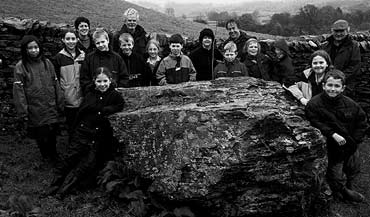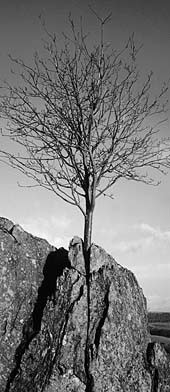MICHAEL JENKINS
Michael Jenkins of Mountjoy Farm, at Underbarrow near Kendal,
describes what happened after Andy Goldsworthy agreed to site
two works for the Sheepfolds project on his land.
Having long been an admirer of Andy Goldsworthy's work, I was
delighted when two sites on our land were to become part of
the Sheepfolds project. Overlooking them, at the highest point
of the farm, is a rowan tree growing through a fissure in a
rock face, and Andy was moved by the brave way it had struggled
to survive and thrive. He decided to place a boulder in each
rebuilt fold, with a rowan growing through it to echo the mature
rowan he had seen.
In the summer of 2000 Andy asked me to find a selection of suitable
boulders, and he came and chose the two largest. That winter,
on a day marked by a prolonged downpour, heavy tracked vehicles
arrived to move them. At the first fold the steep slope and
saturated ground caused the vehicle to slide sideways downhill,
out of control for fifty yards, before it was eventually coaxed
into position. The second, larger boulder took from noon until
after dark to get in place, finally waltzing down the steep
hillside, straight through a dry stone wall – not the gap
I'd prepared for it! Andy directed their final position, showing
where he wanted the holes bored through them, and mapping out
the future walls which would surround them.
In January 2001, together with wallers Steve Allen and George
Allonby, local farmer Andrew Allen and his two boys, we moved
forty tonnes of stone from three field piles, said to have been
cleared by Italian prisoners of war. During the rebuilding,
two clutches of pot eggs were discovered deep in the footings:
they must have been placed there – propitiously or superstitiously
– when the folds were originally constructed. In fourteen
days both folds had been completed, and later that month a specialist
team from Carlisle bored a core four inches in diameter through
the centre of each boulder, using diamond-toothed drills.
Andy had asked me to collect berries from the rowan tree which
had been his original inspiration, and my wife Karen had removed
their seeds. They spent three months germinating in the fridge
before the potting, growing on and nurturing of the seedlings.
We repeated the exercise to be sure that Andy would have the
right size of whip to plant, and collected some fine, friable
earth from molehills for the planting.
One of Andy's original hopes was for local schoolchildren to
follow the project. A group from a nearby school met the wallers,
saw the fold taking shape and were encouraged to add stones:
they took photos and later wrote to Andy about taking part.
The planting was scheduled for February 2001, but the onset
of foot & mouth disease meant this final act had to be postponed
until the all clear. Exactly eleven months later, on 21st November,
another day when rain poured down from a leaden sky, Andy planted
the two strong saplings with the children who had 'helped'.
He spoke about the relationship of stone, wood and sheep, the
agricultural heritage which helped to shape the landscape, and
how these folds had witnessed the arrival, presence and eventual
departure of the foot & mouth outbreak.
Now that the folds are complete, I feel immensely privileged
to have been involved. The fact that they are on Mountjoy land
means not that they belong to us, but that we hold them in trust
for future generations to share their inspiration, as the rowan
trees grow out of stone, enclosed and protected in beautifully
restored folds.

